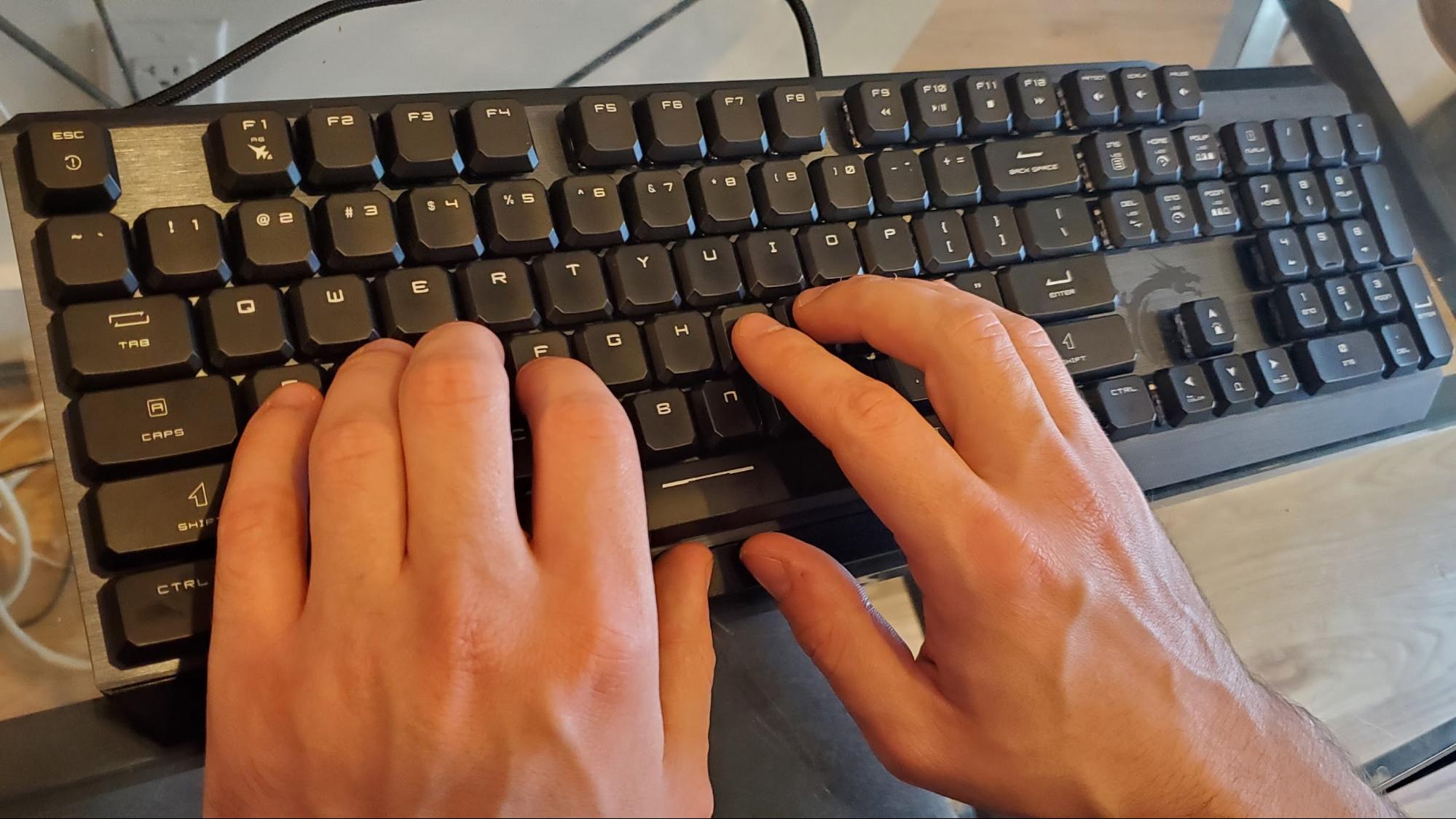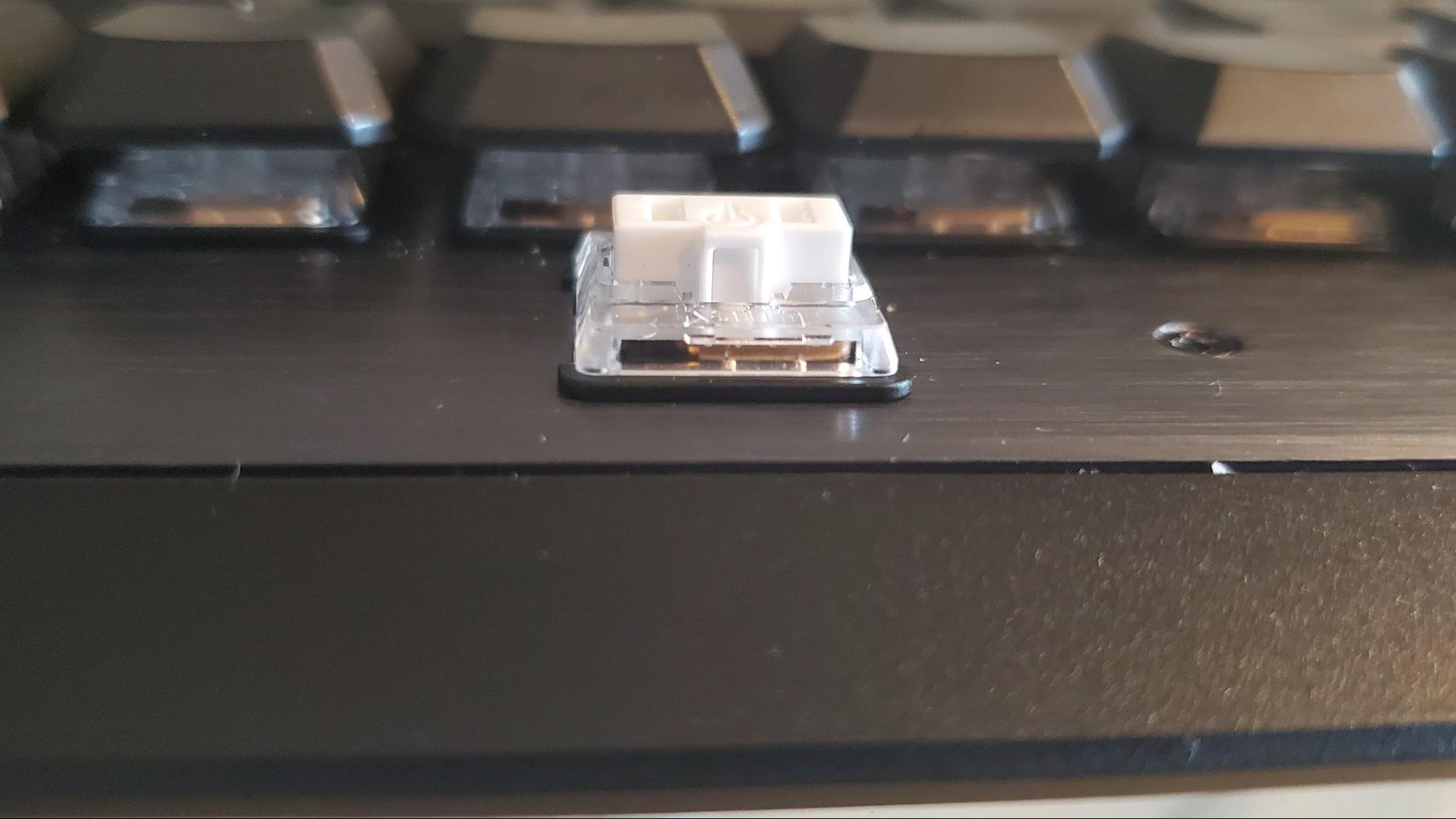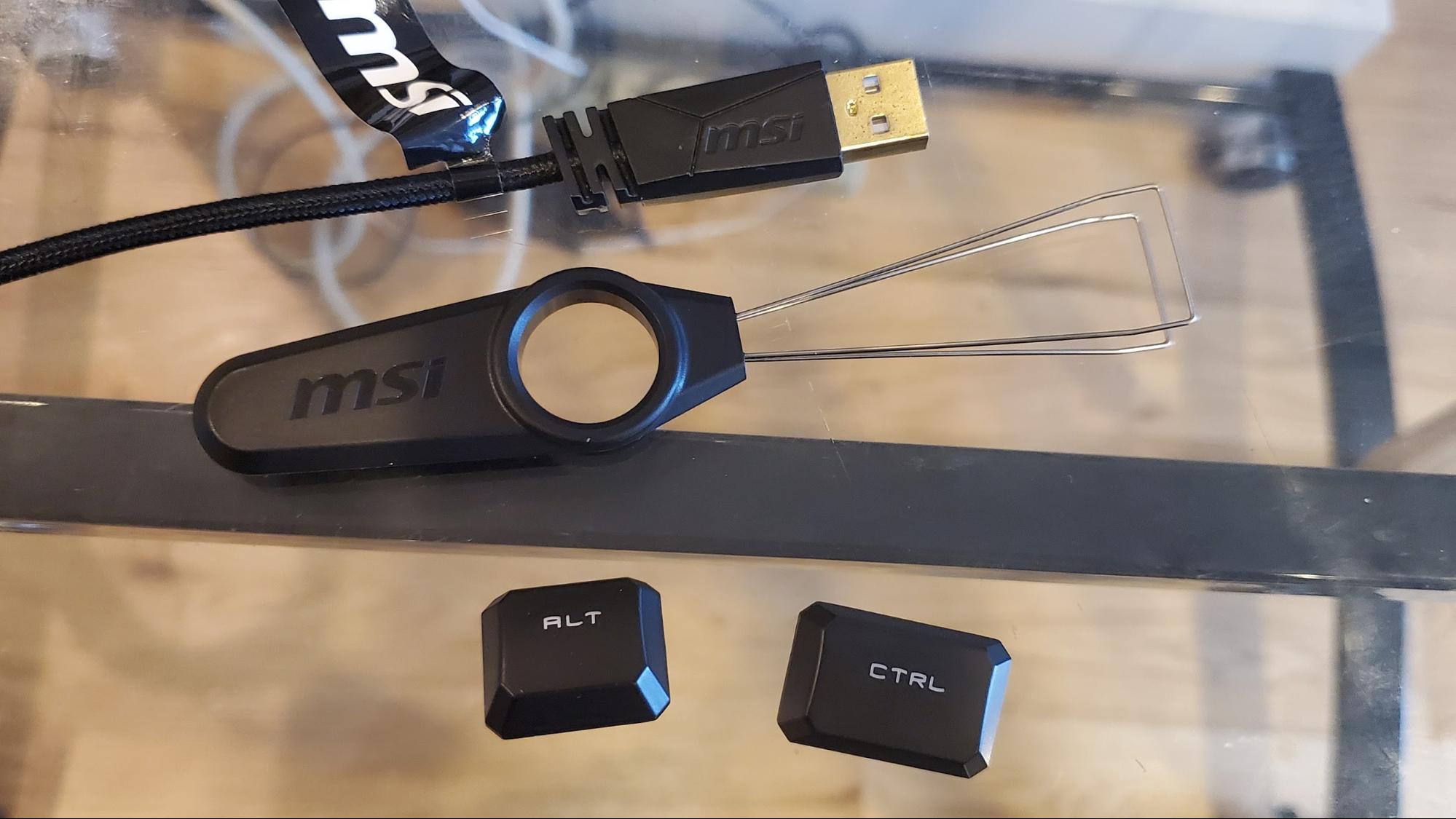Tom's Hardware Verdict
MSI’s Vigor GK50 boasts fantastically clicky switches that turn typing and gaming into a near-nostalgic experience, until modern and bright RGB and a svelte build bring you back to modern times. Customization is limited without working software, but overall it outperforms for a gaming mechanical at this price.
Pros
- +
Typewriter-like typing
- +
Mature and comfortable design
- +
Braided cable
- +
Flashy RGB
- +
Good price
Cons
- -
Software won’t download
- -
Stiff shift key while typing
- -
Stiff spacebar key can be annoying when gaming
- -
No wrist rest
Why you can trust Tom's Hardware
If you’re someone who judges a keyboard based on sounds and clicks, the MSI Vigor GK50 Low Profile ($95 as of this writing) will win your heart. Its Kailh Choc low profile switches and floating keycaps deliver that experience mechanical keyboard enthusiasts crave at a price that competes favorably in today’s market.
Some flaws prevent the clack from being the best gaming keyboard, such as software issues that stop you enjoying the per-key RGB to its maximum potential. But with a versatile design and spirit of a typewriter, it’s still a top contender.
MSI Vigor GK50 Low Profile Specs
| Switches | Kailh Choc White |
|---|---|
| Lighting | Per-key RGB |
| Onboard Storage | No |
| Media Keys | With FN |
| Game Mode | Yes |
| Interface | USB 2.0 |
| Cable | 5.9 feet (1.8m), braided |
| Additional Ports | None |
| Key Caps | Plastic |
| Construction | Plastic base, metal top plate |
| Software | MSI Dragon Center |
| Dimension (WxDxH) | 17.1 x 5.6 x 1.3 inches (435 x 141 x 34mm) |
| Weight | 1.5 pounds (700g) |
| Warranty | 1 year |
| Extra | 1x keycap puller; 2x convex keycaps (left Ctrl and Alt) |
Design
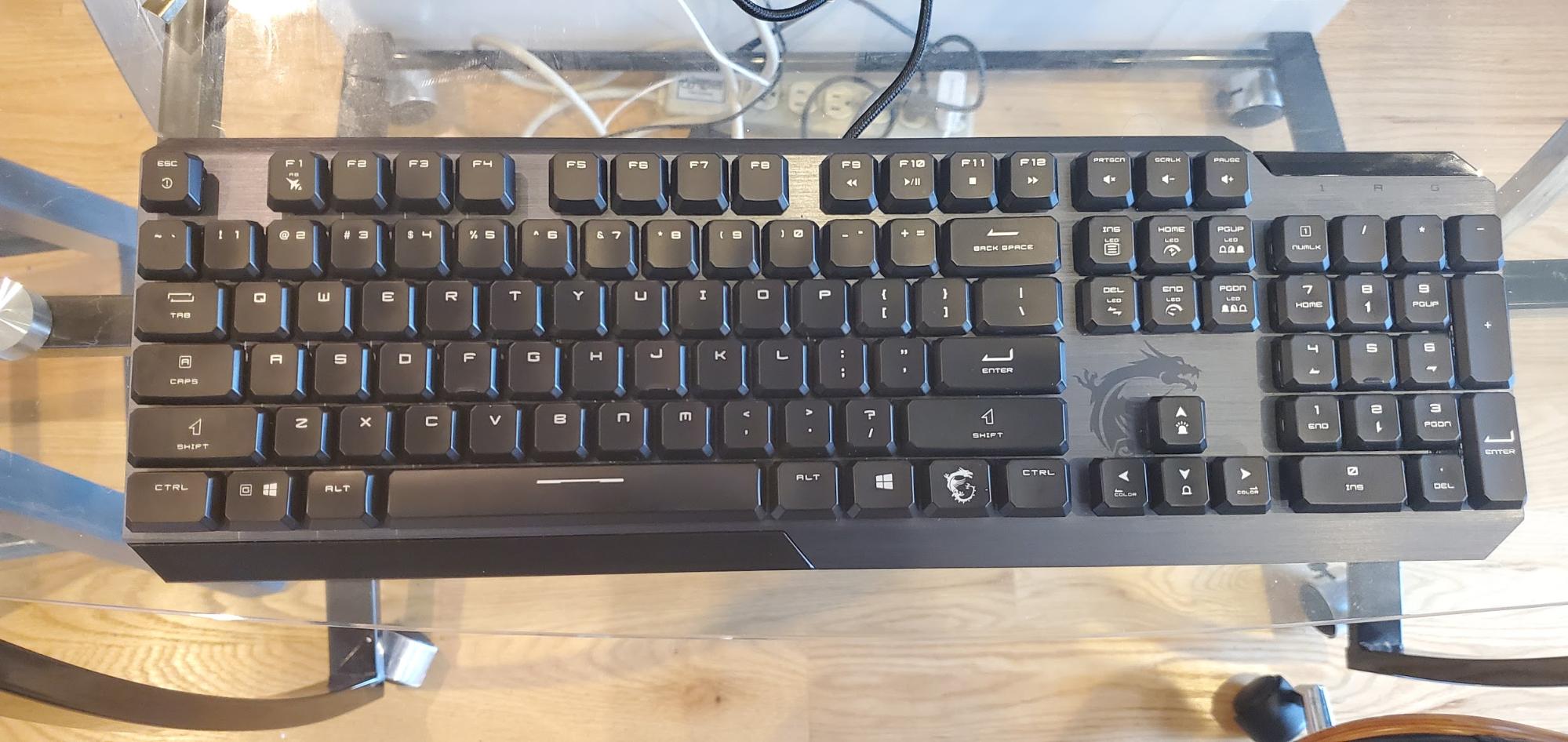


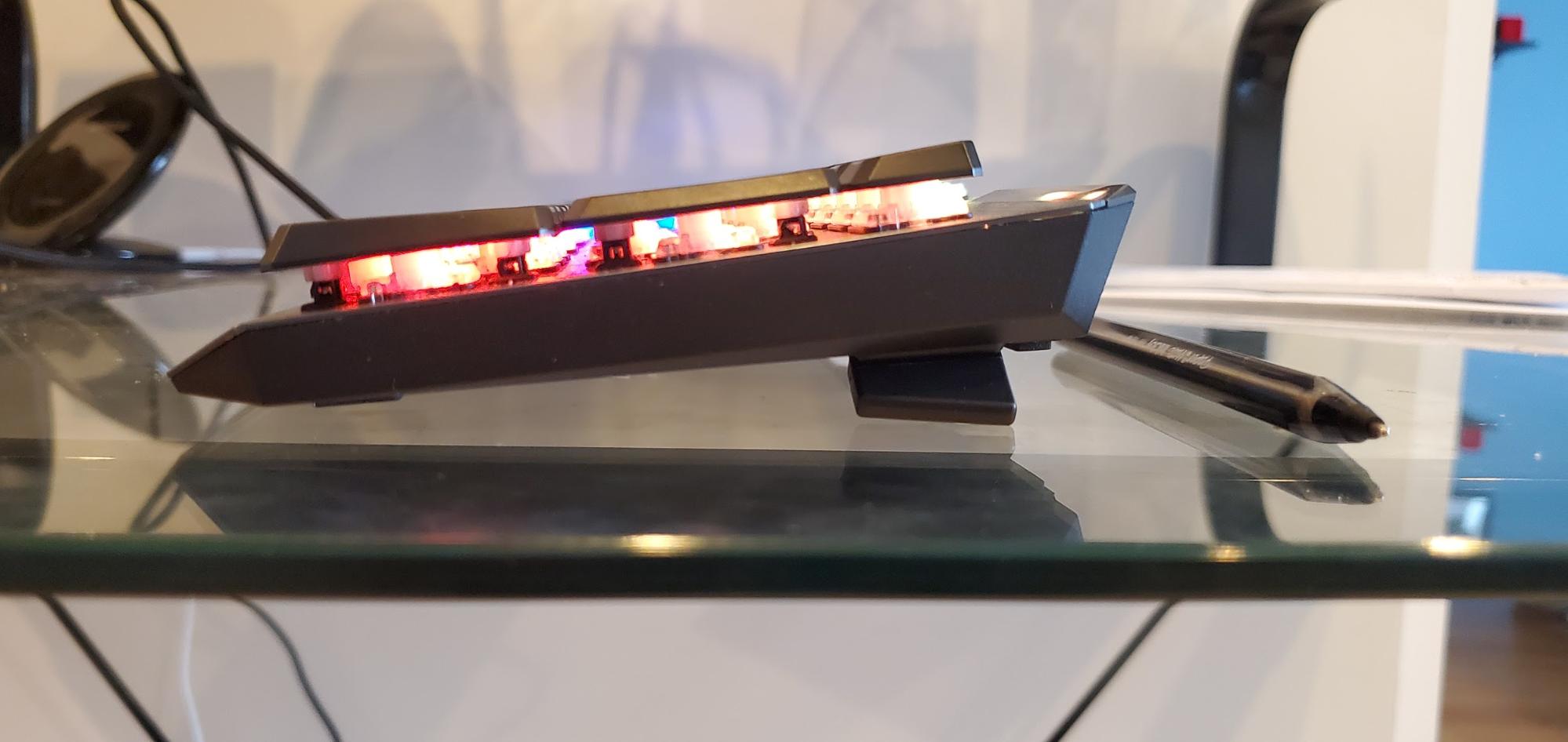
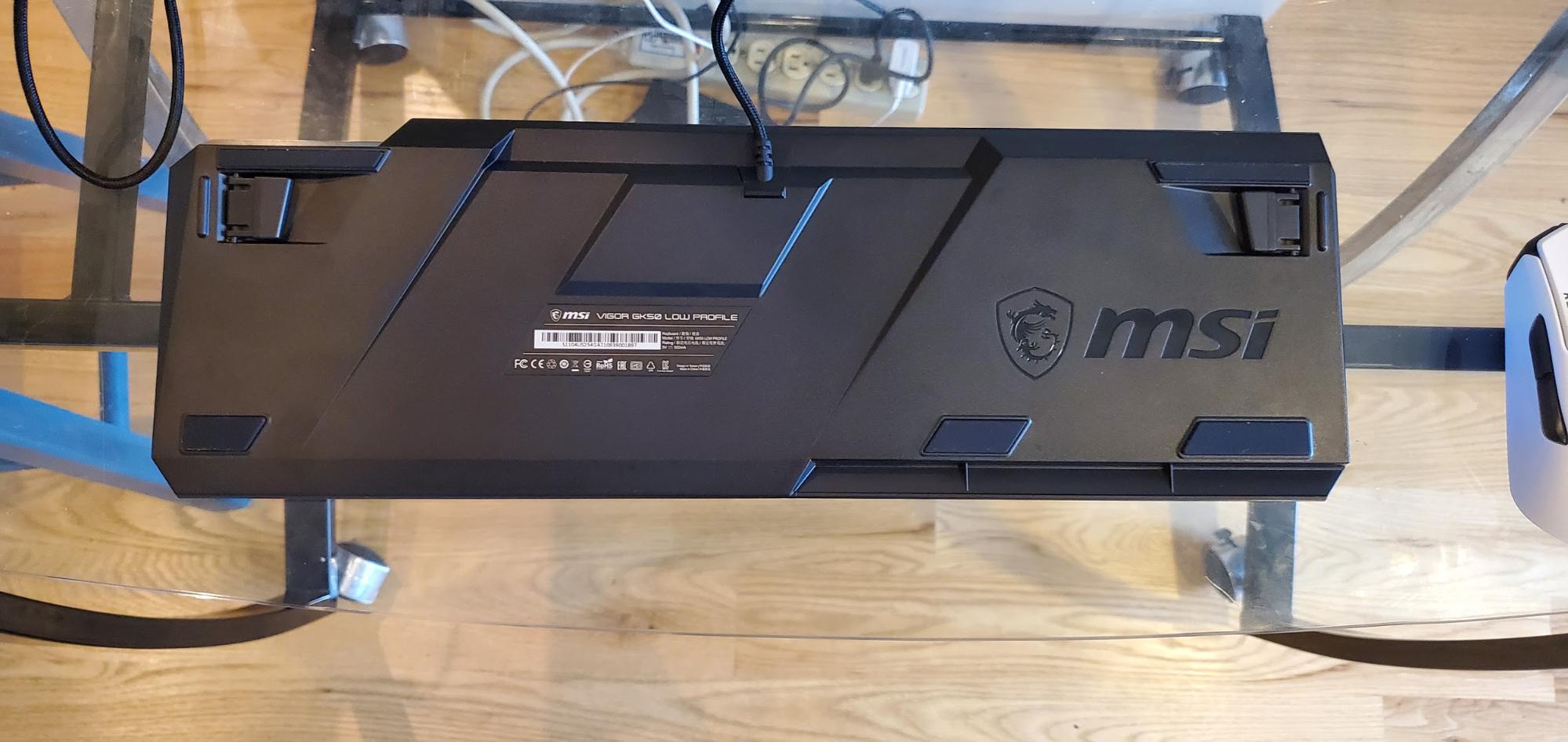
Before you even get to its RGB lighting, the Vigor GK50 sneaks its way into a gamer’s aesthetic with some subtle touches. While its black keycaps and mature-gray, brushed metal top plate say ‘business,’ the keycaps’ octagonal shape and distinct font start telling another story. A floating keycap design also makes things edgier, if you’re looking at the keyboard from the right angle. And at the bottom is a chunk of black to break up all that gray metal even more. Of course, this wouldn’t be an MSI gaming product without an appearance from Lucky the Dragon, the company’s spokescreature. In addition to the dragon-stamped FN key, there’s an identical dragon encircling the arrow keys. He’s just a shade darker than the rest of the chassis, so he’s noticeable without causing a scene.
The Vigor GK50 is standard size for a 104-key keyboard but lightweight. MSI brags of the Vigor’s short, low profile height of 1.3 inches, but overall it’s comparable in size to the HyperX Alloy Origins (17.4 x 5.2 x 1.4 inches), and the Corsair K95 RGB Platinum XT is barely taller (18.3 x 6.7 x 1.4 inches). But while the HyperX adds portability with its removable USB cable, at 2.4 pounds compared to the MSI’s 1.5 pounds, you might prefer taking the latter out, even if you have to wrap its cable around the keys like a barbarian. The K95 is also heavier at 2.9 pounds, and the Vigor GK50 is also slightly more trim and noticeably lighter than the Adata XPG Summoner (17.7 x 5.3 x 1.7 inches, 2.1 pounds). But the Corsair and Adata boards include physical media controls, so you’re essentially cutting function for form.
The Vigor GK50 does offer media control -- as well as RGB lighting control and, for a less obvious reason, its Afterburner graphics card overclocking software -- by holding down the dragon key (you can’t miss it), and identifying the appropriate icon, all of which are straight forward enough.
MSI also built the Vigor GK50 with what it describes as an “ergonomic high-low keycap design” that “reduces strain and pain of hands and wrists.” I used the keyboard for about two weeks, and while the difference is visible from the side, my hands and wrists didn’t notice any changes. In fact, including a wrist rest like many mechanical keyboards do would probably have made a more tangible impact. On the other hand, HyperX’s $20 Wrist Rest is more comfortable than any of those that come with a keyboard.
Flipping the Vigor GK50 over is easy since the thing is so light and reveals some larger MSI branding, two feet that flip out sideways instead of the more traditional upward and five soft rubber feet. The bottom is black plastic, which also sticks out at the front of the keyboard, and is the cheapest feeling part of the keyboard. But because of those rubber feet, the Vigor GK50 stayed put during intense gaming or typing despite only weighing 1.5 pounds.
Get Tom's Hardware's best news and in-depth reviews, straight to your inbox.
Once you do activate the RGB, the Vigor GK50’s floating keycap design amplifies the effect by creating a glow on the keyboard frame. The lighting effects even carry over into the indicator. I could do with a classier font or less puzzling shift and tab key icons, but there are much worse offenders among gaming keyboards today.
Typing Experience
The tapping of keyboards is a constant for office workers. For those who work in an office filled with gamers, that background noise is more like a background chorus of audible mechanical switches crooning with fervor. It might sound annoying, but I actually appreciate working with the white noise. I received my review unit of the Vigor GK50 in the midst of New York City’s lockdown, but despite being in a one-person office for most of the day, it almost felt like I was still surrounded by prolific writers and editors. With a shamelessly loud sound profile and typing experience that evokes a typewriter, the Vigor GK50 nearly made up for the lack of fellow mechanical typists.
The Kailh Low Profile Choc White switches are naturally clicky, and combined with their speedy response seemingly propelling my fingers into springing action and the occasional echo from the metal top plate (especially when hitting the spacebar) gave me those typewriter feels. The Vigor GK50’s keycaps are matte to avoid fingerprints, which they did successfully during my two weeks with it, and feel less like that dated piece of tech I remember fondly. But everything going on under those caps and the resulting sounds brought pleasant memories and an eagerness to type. What’s the first thing anyone does when they see an old typewriter? Bang their fingers across it for that classic sound. With the Vigor GK50 on your desk, you’ll have that desire daily.
The Vigor GK50’s Choc White low profile switches have 3mm of total travel and actuate at 1.5mm. Cherry’s MX Low Profile Red switches have 3.2mm travel and 1.2mm pre-travel, while its MX Low Profile Speed switches have 3.2mm travel with 1mm pre-travel. But while Cherry’s low profile switches actuate at a shorter distance, neither of them have audible clicks like the Kailh low profiles here. A light tap activated input that felt quick and instant, and simultaneously, the total travel didn’t feel too shallow.
Stand out keys are the spacebar and shift button, which both offer a little more resistance than the other keys. This isn’t unheard of with the spacebar, a key of action, and we’ve even seen some vendors opt for alternate switches for the key. We looked, and the spacebar and shift keys use the same Kailh Low Profile switches, but there are also two latches framing each switch for increased resistance. I welcomed this in the spacebar, just like I enjoyed the switch choices in the G.Skill KM360, which has linear Cherry MX Red switches for every key except the Cherry MX Black spacebar requiring more force to actuate and a noticeably stiffer feel. But the MSI’s shift key, which I use often in daily writing, having an extra layer of stiffness was more of a hindrance than anything else.
As mentioned, the keyboard’s high-low keycap design didn’t have an immediately noticeable effect on my hand or wrist comfort. But the keycaps’ very slight (nearly impossible to see) indent provided comfy places for my fingers to rest, except for the more rigid spacebar. The keys also managed to stay wobble-free during rapid typing, even though I could gently move them if I tried.
On the 10fastfingers.com typing test, I usually average about 108 words per minute (wpm) with 98% accuracy. With the Vigor GK50, I surpassed expectations, hitting up to 124 wpm with 98.4% accuracy and averaging 118 wpm with 98.4% accuracy. The Vigor GK50’s use of speedy switches and well-designed keycaps seemed to heighten my speed.
Gaming Experience
With low profile Kailh Choc switches, MSI clearly built the Vigor GK50 for gaming. Actuating at 1.5mm, the mechanical switches are more than capable of handling rapid firing of buttons. One difference compared to low profile Cherry switches is that you have just 3mm total travel here before bottoming out, instead of 3.2mm. Plus, the Cherry Low Profile Red and Speed switches actuate at a 1.2mm and 1mm, respectively. If you’re extremely competitive or want the smallest amount of travel possible, there are other options.
There is a different story to tell, however, when trying to rapidly press the spacebar in a game. As mentioned, latches surrounding the switch make the spacebar feel more resistant. When trying to press it multiple times, like to jump quickly for dodging, the spacebar felt like it was getting stuck behind and couldn’t keep up. Overall, the spacebar just isn’t as easy to press as the other buttons on the board. But the other keys, partially thanks to having the right amount of distance between them, were easy to identify and activate on the Vigor GK50.
The keyboard also sports n-key rollover. When I tested with an online tool, I was able to confirm at least 58 keys and anti-ghosting. Additionally, MSI includes alternate Ctrl and Alt keys (and a keycap puller) that have convex humps instead of indentations in order to make them easier to push rapidly. These keys are pretty out of reach from the WASD keys, so I personally didn’t find much use for them while gaming. But if you do, you’ll notice that the convex keycaps are slightly taller, definitely making them easier to locate blindly.
Features and Software
The Vigor GK50 is supposed to work with MSI Dragon Center software, but at the time of this writing the software won’t download properly. MSI confirmed the issue but didn’t have a timeline for a resolution. The lighting is also supposed to work with MSI Mystic Light, which lets you set matching RGB among supported RGB PCs, components and peripherals from MSI.
Without the software, however, you can still cycle through pre-made RGB effects, but some options, like a color picker, are missing. You can change the RGB effect through hotkeys by pressing the Dragon button and one of the navigation keys, which are all labeled for RGB control, including effect, direction, speed, brightness and color. There’s also a brightness control and “shadow” one, but I couldn’t see a difference on my keyboard when pressing this.
Despite lacking software, I was able to test out 8 different color effects, plus off. This included Overlap, which shoots out a ripple of white lighting with each button press and Breath (aka breathing), which I’m normally not a fan of but looked great when I toggled to the rainbow color scheme. The result was a gradient wave of rainbow colors that was almost as nice as some of the effects attainable on the SteelSeries Apex Pro without opening the software -- almost.
Outside of that, the Vigor GK50 is lacking in bonus features. You do get other hotkeys, for controlling music, locking or unlocking the Windows key or activating MSI Afterburner software, for graphics card overclocking.
Bottom Line
The MSI Vigor GK50 easily fits into a gaming or office set-up with a sharp design that manages to be portable, stable and classy, and yet flashy when you activate the RGB packing an extra punch among floating keycaps. For mechanical keyboard fans whose fingers miss using typewriters as a canvas, the Vigor GK50 is a gift with just the right tune of clickiness.
During gaming, however, a resistant spacebar can be a hindrance. You’re also working with a noticeably stiff shift key. MSI tries to make up for things with concave Ctrl and Alt keys, but their helpfulness isn’t a given. You’re also missing out on a lot of functionality right now, as the keyboard’s companion app doesn’t download properly as of writing.
But at $95, the MSI Vigor GK50 is a value buy without (too) much sacrifice.

Scharon Harding has over a decade of experience reporting on technology with a special affinity for gaming peripherals (especially monitors), laptops, and virtual reality. Previously, she covered business technology, including hardware, software, cyber security, cloud, and other IT happenings, at Channelnomics, with bylines at CRN UK.
-
waltc3 Can't do the mechanical keyboard thing...;) I don't really think my hands are all that large--maybe medium largish, possibly. The mech keyboards I've tried--even bought a couple to try, $35 and $75--are simply too small for my hands to navigate comfortably. (I didn't see much difference between the $35 version and the $75 version, either.) For many years I was a rabid Logitech Illuminated keyboard K790(?) (wired--I won't do wireless, either) fan--loved the feel of the keys. Problem was they sold for ~$70+ and I bought two back to back once for the simple reason that the period key (underneath the > sign) wore through on each, cracking in half on one of them--and amazingly, I scoured the Internet for replacement keys and couldn't find a single one--not from AMZN and not from Logitech--the Logitech site (pretty poor to navigate, imo) said "No replacement parts available." Yet the Illuminated Keyboards are still being sold new, apparently!Reply
Also, the "clackety clack" sound of the mechanicals I do not in any way find to be some kind of advantage--I know if I've hit a key or missed it immediately and audible feedback like this is of no help. I find all of that clacking very distracting at first, becoming annoying rather quickly. There are/were gazillions of typewriters made, both good and horrible--and all in between--so "Types like a typewriter" need not be a positive comment at all, imo!
So now...I've tried just for fun a cheap, $37.95 RGB/Illuminated, wired, 'Gaming" keyboard from Red Dragon, of all brands to pick for a keyboard (although their mice seem about the best buys available for laser mice, imo) ...;) I am keeping it! The keyboard is closer to the Logitech keyboards I had than the mechanicals--a lot closer, actually in terms of size and comfort for my hands--but it's a compromise! The Logitech keyboard was very quiet when I typed, which I liked a lot--and even though this RD kbd is much noisier it is still noticeably quieter in operation than the loud, clacking mechanicals I had.
https://www.amazon.com/gp/product/B00NLZUM36/ref=ppx_yo_dt_b_asin_title_o00_s00?ie=UTF8&psc=1
(Included mouse went to the spare parts drawer.)
I thought your review here was fine--you are far more of a professional typist than I am--on a good day I might average 50-60 wpm with a key error rate of 10%-15%, so, yea, I am a lame typist! I'm not sure what it is, really, that turns me off most about mechanical keys--other than the annoying sound and what seems like a tiny keyboard to me. I also enjoy keyboard reviews--always looking for something better, of course. But the one thing that turns me off quickly is when I encounter a spate of cookie-cutter, mechanical keyboard product reviews! (Not the case here) I'd like to see keyboard reviews that center around the qualities I look for--quiet operation, a spacious keyboard for medium-large hands, decent keyboard illumination which doesn't have to be "RGB", IE, a little bit different set of desirable qualities!
